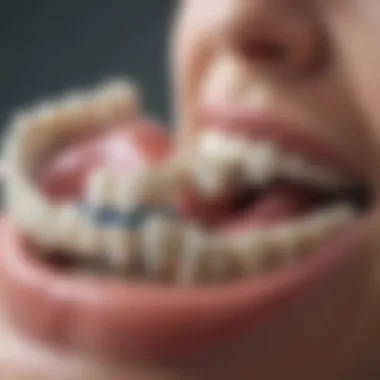Does Medicaid Cover Dental Work? A Comprehensive Guide


Intro
Medicaid provides a critical safety net for millions of people in the United States, assisting individuals and families in accessing healthcare services. While many are aware of its role in covering medical care, few realize the extent of its provisions for dental work. This topic is essential for those who rely on Medicaid for their health needs, particularly the often-overlooked aspect of dental health. Understanding the specifics of what Medicaid covers in terms of dental services can create better informed communities that know how to navigate eligibility and access these critical resources.
This article delves into the nuances of Medicaid's dental coverage. It explores the different services covered, eligibility requirements, and the variations that exist across states. More importantly, it aims to empower readers with information that aids in making sound dental health decisions, helping them to understand their rights and options.
Overview of Dental Medicaid Coverage
Medicaid dental coverage is not a standalone service; instead, it functions within the broader framework of Medicaid health care provisions. At its core, Medicaid aims to promote health equity by making basic healthcare accessible to low-income populations, which includes a focus on dental health.
Definition of Coverage
Medicaid dental coverage includes a variety of dental services. These services typically cover preventative, diagnostic, and emergency treatments. Yet, specifics can vary significantly depending on the state. Some states provide expansive services, while others might restrict coverage to emergency procedures only.
Importance of Dental Coverage for Consumers
Access to dental health services is primary not only for maintaining oral hygiene but also for overall health. Untreated dental conditions can lead to severe complications, including heart disease, diabetes, and other chronic conditions. Therefore, understanding Medicaid’s dental provisions is vital for those who may otherwise face financial barriers to treatment.
Types of Services Covered
Depending on the state, Medicaid may cover various services, such as:
- Preventive Services: Routine cleanings, X-rays, and examinations.
- Basic Restorative Services: Fillings, extractions, and root canals.
- Emergency Services: Pain relief or treatment for injuries affecting the mouth.
- Orthodontic Services: Limited circumstances typically apply.
Grasping these distinctions is important for consumers to seek the care they need without confusion or fear of unexpected costs.
Variations in Coverage Across States
While Medicaid is federally funded, individual states administer their own programs, leading to differences in dental coverage. Some states may offer comprehensive benefits, while others may focus narrowly on emergency care. For instance, Texas provides limited coverage, while California includes a broader range of services.
Keeping informed about differences in local policies can empower Medicaid subscribers to maximize their available benefits.
Navigating through these disparities requires ongoing effort and research on the part of consumers to understand where their state stands in terms of dental coverage under Medicaid.
Understanding Medicaid and Dental Coverage
Understanding Medicaid and its dental coverage is crucial in dissecting how low-income families and individuals access essential dental services. Dental health directly impacts overall health, yet many people remain unaware of the resources available to them under Medicaid. This section aims to shed light on the underlying mechanisms of Medicaid and its dental policies, highlighting their significance in the broader context of healthcare.
Overview of Medicaid
Medicaid is a joint federal and state program designed to provide healthcare to low-income individuals, families, and specific vulnerable populations. Its implementation varies from state to state, making it important to understand the local context to utilize the benefits effectively. The coverage includes a wide range of medical services but dental coverage can differ significantly, depending on state laws and policies.
The program aims to bridge the gap for those who might otherwise lack the means to access necessary healthcare services. Under the Medicaid framework, several dental services are covered, yet they often operate under different regulations compared to other essential health services. It is vital for beneficiaries to comprehend these differences and actively seek dental care as part of their overall health strategy.
General Dental Coverage Policies
Medicaid seeks to provide essential dental care, though the specifics of coverage can vary. Generally, Medicaid covers basic dental services for children, including preventive check-ups, cleanings, and fillings. However, adult dental coverage is far more limited. Some states might offer a range of services, while others restrict access to only emergency procedures.
For instance, common procedures may fall under categories like:
- Preventive services: Usually include examinations and cleanings.
- Restorative services: Typically cover fillings and crowns.
- Emergency services: May involve tooth extractions or treatment of severe infections.
It is critical for beneficiaries to consult their state's Medicaid guidelines to grasp what dental services are available to them. Moreover, local dental health providers can clarify the scope of services offered in conjunction with Medicaid.
Navigating these policies is essential for individuals, especially those who depend heavily on Medicaid for their healthcare needs. Understanding the specifics of what’s covered allows for better planning of oral health maintenance, while also reducing the risk of unexpected out-of-pocket expenses.
Types of Dental Services Covered by Medicaid
Understanding which dental services are covered by Medicaid is crucial for individuals seeking dental care under this program. The coverage varies significantly by state and includes different types of services necessary for various dental health needs. Medicaid aims to provide essential health services, and its dental provisions reflect that mission. Knowing what services are available can help recipients make informed decisions about their dental health.


Preventive Services
Preventive dental services are fundamental components of Medicaid's dental coverage. These services are designed to maintain oral health and prevent future dental issues. Common preventive services include:
- Routine examinations
- Professional cleanings
- X-rays
- Fluoride treatments
- Sealants
Accessing preventive services can lead to early detection of dental problems, thus reducing the risk of more complicated and potentially expensive treatments later. For Medicaid recipients, these services help enhance overall health. Regular dental check-ups can not only improve oral health but also positively affect general well-being.
Restorative Services
Restorative services address existing dental issues. Medicaid covers a range of restorative procedures, enabling patients to maintain functional and aesthetic dental health. These services may consist of:
- Fillings for cavities
- Crowns
- Bridges
- Dentures
The coverage for restorative services is vital. Many individuals with lower incomes may face barriers to accessing necessary treatments without insurance. Medicaid's provisions help bridge this gap, allowing individuals to manage their dental problems effectively and avoid further complications.
Orthodontic Services
Orthodontic services are critical for many children and adults who require alignment or correction of their teeth and jaws. Coverage for orthodontic services typically includes:
- Braces
- Retainers
Medicaid's orthodontic services can vary. Some states provide coverage based on medical necessity, while others may offer limited services. It is essential for beneficiaries to understand their state's specific policies surrounding orthodontics to make suitable decisions for treatment.
Emergency Dental Services
Emergency dental services play a significant role in Medicaid's coverage framework. These services are essential for individuals facing acute dental issues that require immediate attention. Typical emergency services include:
- Tooth extractions
- Treatment of abscesses
- Pain management for dental emergencies
Emergency dental care ensures that beneficiaries do not suffer prolonged pain or complications due to untreated dental issues. Access to such services through Medicaid is crucial for maintaining health and quality of life.
Eligibility for Medicaid Dental Coverage
Determining eligibility for Medicaid dental coverage is essential for individuals seeking assistance with dental expenses. Understanding the factors that influence eligibility can significantly affect access to needed dental care. This section will delve into various elements, benefits, and considerations surrounding Medicaid’s dental coverage eligibility, offering readers valuable insights that can inform their decisions related to dental health.
Eligibility Criteria Overview
Eligibility for Medicaid dental coverage generally aligns with the overall eligibility for Medicaid itself. To qualify, individuals must meet specific criteria related to income levels, age, disability status, and residency. Many states follow federal guidelines, but they also have the flexibility to expand or restrict coverage based on their regulations.
Moreover, the qualification process can vary. Some states may offer broader dental coverage under Medicaid, while others may limit services. It is important for potential Medicaid recipients to familiarize themselves with the rules in their state. Enrolling in a Medicaid plan can help mitigate the financial burden of dental care, thereby enhancing one's overall well-being.
Income Requirements
Income levels play a pivotal role in determining eligibility for Medicaid dental coverage. Each state has a specific income threshold based on the Federal Poverty Level (FPL). Generally, individuals or families whose income is at or below this threshold might qualify for Medicaid.
Income verification is usually necessary, and applicants may need to provide documentation such as tax returns or pay stubs. Some states have different requirements for various demographic groups, including children, pregnant women, and the elderly.
Understanding these income requirements can assist potential applicants in navigating the Medicaid application process successfully.
State-Specific Regulations
State-specific regulations significantly impact the eligibility and extent of Medicaid dental coverage. Each state has the power to design its own Medicaid program, leading to variation in what services are covered and who qualifies for coverage.
For instance, some states may offer comprehensive dental services for low-income adults, while others might limit coverage primarily to children or those with special needs. This inconsistency means individuals must explore their state's Medicaid guidelines to grasp what services they can access.
As a result, staying informed about changes in state regulations is crucial for potential beneficiaries. Medicaid’s dental coverage landscape is ever-evolving, and understanding state-specific policies can lead to better outcomes in achieving dental health goals.
“Eligibility for Medicaid dental coverage is influenced by various factors: income, state regulations, and specific criteria. Awareness of these components can empower individuals in need of dental care.”
Limitations of Medicaid Dental Coverage


Understanding the limitations of Medicaid dental coverage is crucial for individuals seeking affordable dental care. While Medicaid provides essential dental services to eligible beneficiaries, it is important to recognize that these benefits come with specific restrictions. Understanding these boundaries aids recipients in planning their dental health care and making informed decisions.
Service Limitations
Medicaid dental services are not as comprehensive as private insurance. States determine what specific dental services are covered under their Medicaid programs, resulting in variability in access to certain treatments. For example, many states offer preventive services such as cleanings and exams, but there may be limitations on restorative procedures like crowns or bridges. Moreover, some states restrict the number of visits per year or require specific clinical guidelines to be met before services can be authorized. This can cause delays in treatment, affecting overall oral health.
Frequency of Treatments
Another important aspect is the frequency of treatments covered. Medicaid programs often stipulate how often patients can receive particular services. Typically, routine check-ups may be covered twice a year, but more complex procedures might have stricter guidelines. Patients may find themselves needing treatment for severe dental issues only to discover limitations on how often they can receive necessary care. This highlighted frequency regulation can create a gap in timely intervention, which is essential for keeping dental problems at bay.
Exclusions of Certain Procedures
Beyond frequency limitations, Medicaid also excludes various advanced dental procedures. Cosmetic treatments like teeth whitening or veneers are not covered at all. Additionally, surgical procedures, such as orthodontic work, might only be covered under specific conditions, often requiring prior authorization based on medical necessity. Patients need to carefully review their state's Medicaid plan to understand these exclusions, which can significantly impact their treatment options.
In summary, while Medicaid provides valuable dental care, it is essential to be aware of the limitations in order to navigate the system effectively.
In light of these limitations, insight into the services offered is imperative. Planning dental care around these constraints will ensure that individuals make educated choices appropriate to their needs.
Navigating Medicaid Dental Benefits
Understanding how to navigate Medicaid dental benefits is crucial for anyone seeking dental care under this program. Many people may not fully realize the extent of their benefits and how to effectively utilize them, which can lead to confusion and potentially missed opportunities for necessary services. Familiarity with the navigation process can empower individuals to take better control of their dental health.
Finding a Medicaid Dentist
Choosing the right dentist is a significant step in accessing Medicaid dental benefits. Not all dental providers accept Medicaid, so it's essential to find one that does. The Medicaid program typically has a network of dentists who are enrolled in the plan, and patients should ensure that the dentist they choose is within that network.
To find a Medicaid dentist, individuals can:
- Contact State Medicaid Office: Each state has a Medicaid office which provides a list of participating dental providers.
- Visit Official Websites: Many states have online portals that list dentists accepting Medicaid.
- Local Health Departments: They can also provide referral resources for finding a dentist in the area.
Being proactive in this search ensures that individuals can receive the necessary dental services without additional financial burden.
Understanding Your Personal Benefits
Being aware of the specific benefits you are entitled to under Medicaid is crucial for effective dental care. Each state has its own rules regarding what dental services are covered. Generally, Medicaid covers preventive services, basic restorative procedures, and in some cases, more advanced treatments. However, the extent of coverage can greatly vary.
Important personal benefits to consider include:
- Preventive Care: Check-ups, cleanings, and x-rays usually fall into this category.
- Restorative Treatments: Fillings, crowns, and bridges are often included, but prior authorization may be required for some procedures.
- Orthodontics: Not all states provide coverage for orthodontic services, so this should be verified based on individual circumstances.
Individuals should review their Medicaid plan documentation and consult with their dentist to fully grasp their benefits. This understanding will assist in making informed decisions regarding their oral health.
Documentation and Claims Process
The documentation and claims process can be daunting but it is a vital part of receiving Medicaid dental benefits. Accurate and complete documentation ensures that claims are processed efficiently and that individuals can access necessary services without delays.
Steps to follow for documentation include:
- Collect Necessary Information: Patients should gather personal information, Medicaid numbers, and details of treatments to streamline the claims process.
- Understanding Claim Forms: Familiarize yourself with the claim forms that your dentist will submit to Medicaid. Many are standardized, but variations may exist by state.
- Follow Up: After submitting a claim, it is wise to follow up to ensure it has been received and is being processed. This can prevent delays and ensure timely service.
Tip: Keeping a personal log of all dental appointments and treatments can aid in the claims process. This log can help if any discrepancies arise between the services provided and what is claimed.
Managing Medicaid dental benefits effectively can significantly impact one’s dental health journey. With proper knowledge and resources, individuals can maximize their Medicaid coverage and address their dental needs adequately.
Comparative Analysis with Private Dental Insurance
Understanding the differences between Medicaid dental coverage and private dental insurance is essential for consumers. This comparison sheds light on the nuances between these two forms of dental coverage. Various aspects, including cost, coverage scope, and consumer satisfaction, play a role in assessing the value of each option.
Cost Comparison


When evaluating costs, Medicaid often presents a more accessible option for low-income individuals and families. Generally, Medicaid covers a range of dental services at little or no cost to the beneficiary. This is crucial for those who may not afford private insurance premiums. In contrast, private dental insurance typically requires monthly premiums, copayments, and deductibles.
- Medicaid Advantages: Low cost, limited out-of-pocket expenses, guaranteed coverage for essential services.
- Private Insurance Disadvantages: Higher overall expenses, potentially limited benefits depending on the plan.
It is important to note that while Medicaid may seem less expensive upfront, the coverage it offers can often be limited in scope. Consumers must weigh these costs against their unique dental needs.
Coverage Scope
The coverage scope differs notably between Medicaid and private dental insurance. Medicaid often focuses on essential services such as preventive care and emergency treatments. On the other hand, private insurance might provide broader coverage, extending to elective treatments and advanced procedures. This means that individuals with private insurance may have access to procedures like cosmetic dentistry, which Medicaid usually does not cover.
- Medicaid Coverage: Preventive services, emergencies, basic restorative work.
- Private Insurance Coverage: Comprehensive services including orthodontics, cosmetic procedures, and more extensive restorative care.
A thorough understanding of what each option covers enables consumers to better assess their choices regarding dental care.
Consumer Satisfaction
Consumer satisfaction is another critical factor when comparing Medicaid and private dental insurance. Satisfaction levels can vary based on individual experiences and specific coverage details. Generally, those enrolled in Medicaid report higher satisfaction with the cost-effectiveness of the program; however, the limitations of coverage can lead to frustration. Consumers may feel they lack options. In contrast, private insurance users often appreciate the more extensive coverage options but may express dissatisfaction over rising costs and complex claim processes.
Research indicates that customer satisfaction with dental insurance can hinge on the ease of access to services and the clarity of what is covered.
Ultimately, understanding these factors can help individuals decide whether Medicaid dental coverage or private insurance aligns better with their needs and expectations.
Future of Medicaid Dental Coverage
Understanding the future of Medicaid dental coverage is paramount for many individuals relying on this crucial safety net. As the landscape of healthcare continues to evolve, specific elements, benefits, and considerations will significantly impact access to necessary dental services. Knowing what changes might be on the horizon enables informed choices when seeking dental care under Medicaid.
Policy Changes on the Horizon
The potential for policy changes in Medicaid dental coverage can create waves of both opportunity and challenges. Lawmakers and policy advocates often discuss expanding coverage to include more comprehensive dental services, reflecting an understanding of oral health's integral role in overall wellness. Historically, many states have limited the scope of services, primarily focusing on emergency dental care. However, movements advocating for holistic health methods may lead to re-evaluations of these limits.
Key aspects of upcoming policy changes may include:
- Expanded Service Lists: There is talk about including dental procedures such as crowns and root canals, which have traditionally been excluded.
- Increased Funding: More state funds could be allocated to dental services, improving overall access and quality of care.
- Streamlined Processes: Simplifying the claims and approval processes for dental treatments can encourage more providers to accept Medicaid patients.
Keeping abreast of these issues ensures that stakeholders understand how exterior factors influence their access to dental services.
Advocacy for Improved Access
The push for advocacy surrounding Medicaid dental coverage highlights a growing awareness that dental health is often overlooked in discussions about general health care policy. Groups advocating for improved access to dental services aim to bridge the gap between need and availability. Their efforts often center around raising public awareness and lobbying for legislative changes.
The reasons for advocacy include:
- Wider Reach: Many low-income families face barriers to accessing dental care due to coverage limitations. Advocacy can lead to expansion in eligibility criteria, allowing more people to benefit.
- Quality of Care: Raising the standards of dental care through advocacy can enhance the quality of services available to Medicaid recipients.
- Preventive Focus: By emphasizing preventive care measures, advocates can help reduce long-term healthcare costs and improve overall dental health.
Informed advocacy not only brings awareness to the critical nature of dental services but can also prompt significant legislative advancements, ensuring that dental health is no longer an afterthought in Medicaid discussions.
Closure
The discussion around Medicaid's dental coverage is crucial for many individuals. Understanding how Medicaid operates in this area helps to navigate the complexities of dental health options available. The importance of knowing the specific benefits, limitations, and eligibility criteria cannot be overstated.
Summarizing Key Points
In this article, we reviewed the core aspects of Medicaid dental coverage:
- Medicaid Overview: Medicaid is a joint federal-state program aiding in health coverage, with dental services offered variably across states.
- Types of Covered Services: Preventive, restorative, orthodontic, and emergency services can all fall under Medicaid's umbrella, yet their availability depends on state-specific policies.
- Eligibility Requirements: Certain criteria regarding income and residency dictate who qualifies for Medicaid dental coverage.
- Limitations and Exclusions: Medicaid often has service limitations, frequency restrictions, and exclusions for specific procedures, which necessitate a thorough understanding before seeking treatment.
- Navigating Benefits: Finding a Medicaid dentist and knowing how to manage the claims process are vital for maximizing the benefits.
- Comparative Insights: An analysis of private dental insurance versus Medicaid highlights differences in cost and scope of coverage, affecting consumer choices.
- Future Considerations: Policy changes and advocacy for better access are ongoing discussions that could alter the landscape of Medicaid dental coverage in the near future.
By synthesizing these points, readers gain a clearer view of Medicaid's dental coverage framework, arming them with necessary information to approach their dental health needs effectively.
Encouragement for Informed Choices
Informed decisions rely on understanding the dental services that Medicaid provides. It is essential for individuals to educate themselves on the specific terms of their Medicaid coverage. Using the knowledge acquired from this exploration, individuals can make proactive decisions regarding their dental care.
Consider factors such as:
- Consultation with Medicaid Representatives: Talking with Medicaid officials can offer insights tailored to individual circumstances.
- Researching State-Specific Policies: Look deep into your state’s specific policies to ensure that you understand the coverage limits.
- Seeking Professional Advice: Dental professionals familiar with Medicaid can provide useful guidance and insight.
Through thorough research and awareness, individuals can navigate the complexities of Medicaid dental coverage with confidence. By making informed choices, they will likely enhance their dental health outcomes in a system where proper access is paramount.















